|
CHAPTER IV.
HOW THE ADMIRAL SAILED AWAY.
The True Story of Christopher Columbus, Called the Great Admiral | ||
4.
CHAPTER IV.
HOW THE ADMIRAL SAILED AWAY.
THE agreement made between Columbus and the king and queen of Spain was signed on the seventeenth of April, 1492. But it was four months before he was quite ready to sail away.
He selected the town of Palos as the place to sail from, because there, as you know, Captain Pinzon lived; there, too, he had other acquaintances, so that he supposed it would be easy to get the sailors he needed for his ships. But in this he was greatly mistaken.
As soon as the papers had been signed that held the queen to her promise, Columbus set off for Palos. He stopped at the Convent of Rabida to tell the Friar Juan Perez how thankful he was to him for the help the good priest had given him, and how everything now looked promising and successful.
The town of Palos, as you can see from your map of Spain, is situated at the mouth of the river Tinto on a little bay in the southwestern part of Spain, not far from the borders of Portugal. To-day the sea has gone away from it so much that it is nearly high and dry; but four hundred
At the time of Columbus's voyage the king and queen of Spain were
angry with the port of Palos for something its people had done that was
wrong—just what this was we do not know. But to punish the town, and
because Columbus wished to sail from there, the king and queen ordered
that Palos should pay them a fine for their wrong-doing. And this fine
was to lend the king and queen of Spain, for one year, without pay, two
sailing vessels of the kind called caravel's, armed and equipped "for
the service of the crown"—that is, for the use of the king and queen of
Spain, in the western voyage that Columbus was to make.
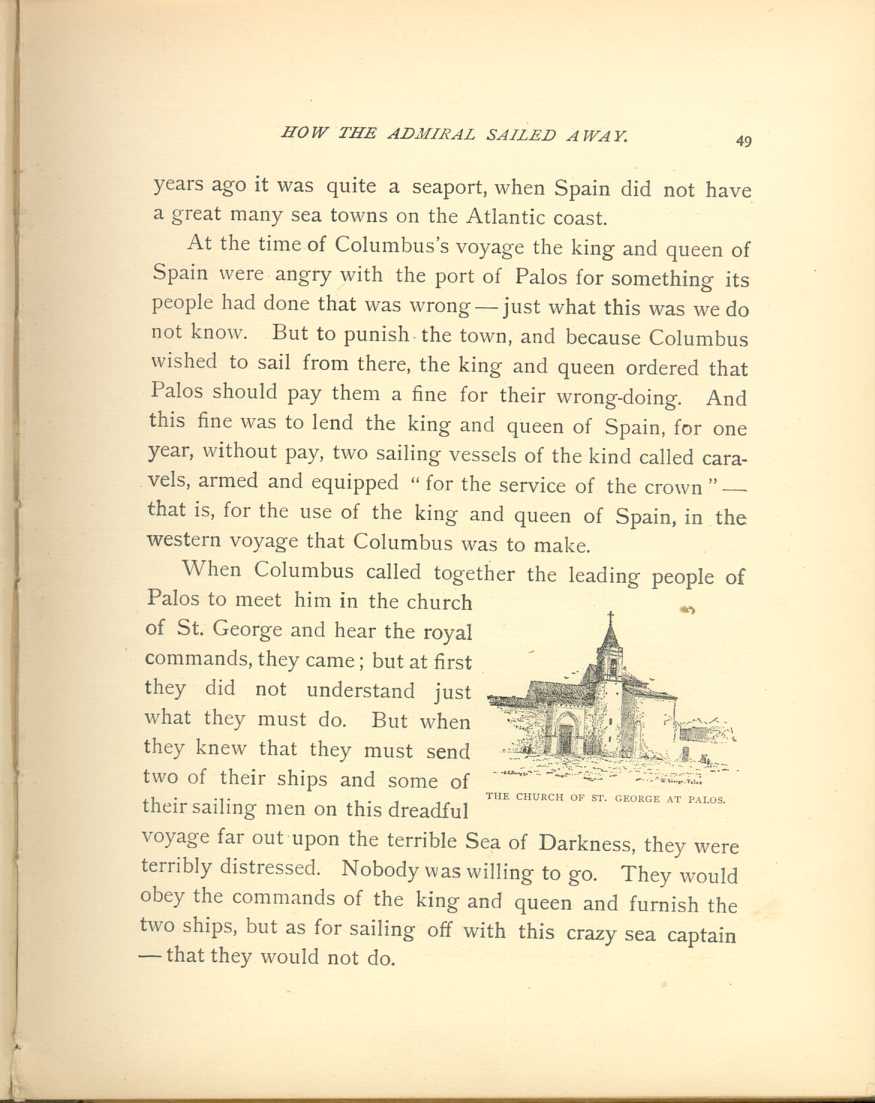
THE CHURCH OF ST. GEORGE AT PALOS
[Description:
Drawing of the Church of St. George.
]
When Columbus called together the leading people of Palos to meet him in the church of St. George and hear the royal commands, they came; but at first they did not understand just what they must do. But when they knew that they must send two of their ships and some of their sailing men on this dreadful voyage far out upon the terrible Sea of Darkness, they were terribly distressed. Nobody was willing to go. They would obey the commands of the king and queen and furnish the two ships, but as for sailing off with this crazy sea captain—that they would not do.
Then the king's officers went to work. They seized some sailors (impressed is the word for this), and made them go; they took some from the jails, and gave them their freedom as a reward for going; they begged and threatened and paid in advance, and still it was hard to get enough men for the two ships. Then Captain Pinzon, who had promised Columbus that he would join him, tried his hand. He added a third ship to the Admiral's "fleet." He made big promises to the sailors, and worked for weeks, until at last he was able to do what even the royal commands could not do, and a crew of ninety men was got together to man the three vessels. The names of these three vessels were the Capitana (changed before it sailed to the Santa Maria), the Pinta and the Nina or Baby. Captain de la Cosa commanded the Santa Maria, Captain Martin Alonso Pinzon the Pinta and his brother, Captain Vincent Pinzon, the Nina. The Santa Maria was the largest of the three vessels; it was therefore selected as the leader of the fleet—the flag-ship, as it is called—and upon it sailed the commander of the expedition, the Admiral Don Christopher Columbus.
When we think of a voyage across the Atlantic nowadays, we think of vessels as large as the big three-masted ships or the great ocean steamers—vessels over six hundred feet long and fifty feet wide. But these "ships" of Columbus were not really ships. They were hardly larger than the "fishing smacks" that sail up and down our coast to-day. Some of them were not so large. The Santa Maria was, as
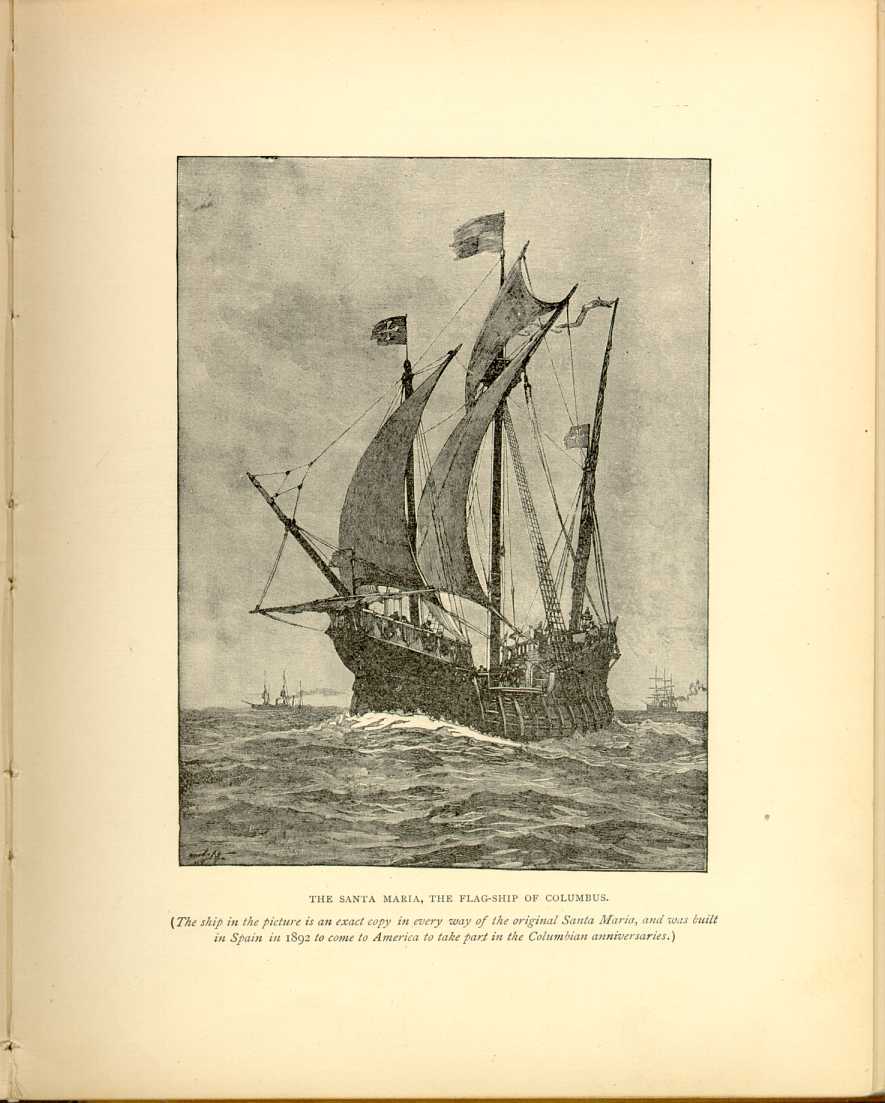
THE SANTA MARIA, THE FLAG-SHIP OF COLUMBUS.
(The ship in the picture is an exact copy in every way of the
original Santa Maria, and was built in Spain in 1892 to come to America
to take part in the Columbian anniversaries.)
[Description:
Drawing of the Santa Maria.
]
But finally the vessels were ready. The crews were selected. The time had come to go. Most of the sailors were Spanish men from the towns near to the sea, but somehow a few who were not Spaniards joined the crew.
One of the first men to land in America from one of the ships of Columbus was an Irishman named William, from the County Galway. And another was an Englishman named either Arthur Laws or Arthur Larkins. The Spanish names for both these men look very queer, and only a wise scholar who digs among names and words could have found out what they really were. But such a one did find it out, and it increases our interest in the discovery of America to know that some of our own northern blood—the Irishman and the Englishman—were in the crews of Columbus.
The Admiral Columbus was so sure he was going to find a rich and civilized country, such as India and Cathay
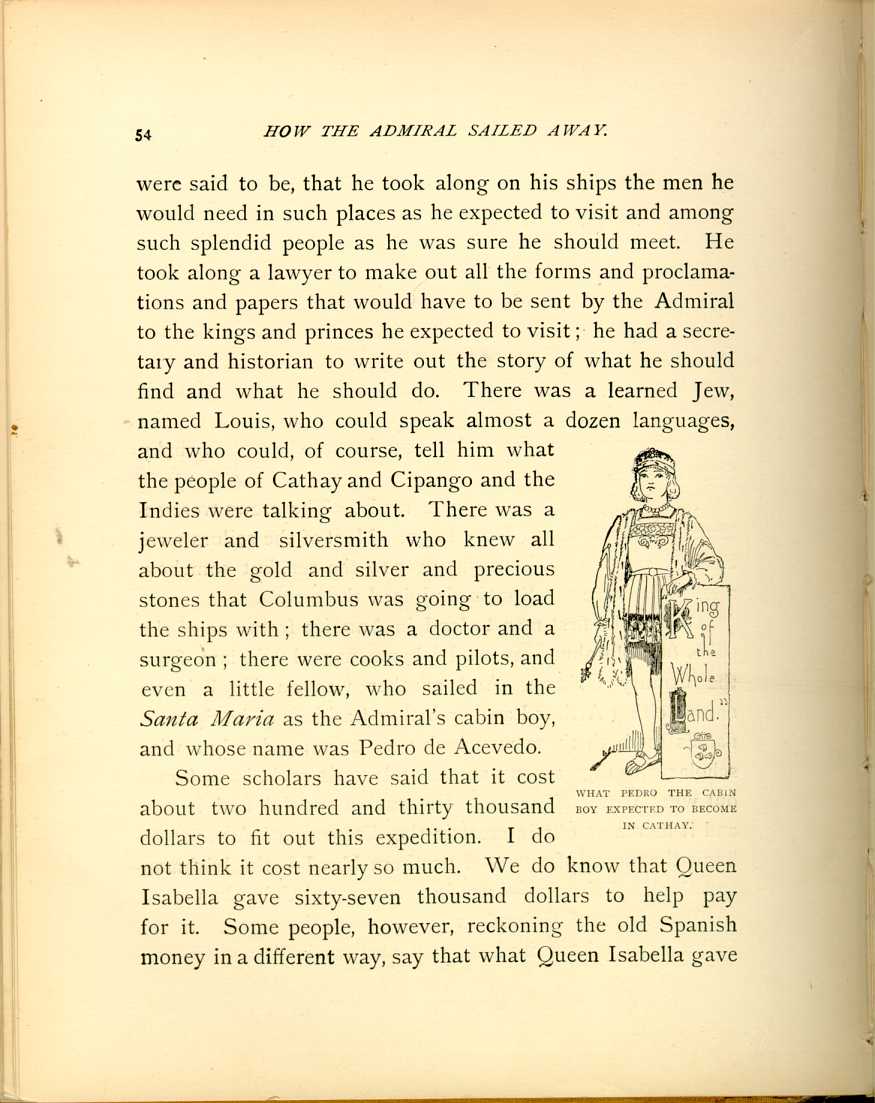
WHAT PEDRO THE CABIN BOY EXPECTED TO BECOME IN CATHAY.
[Description: Drawing of Pedro with a crown on his head and a sign reading "King of the Whole Land." ]Some scholars have said that it cost about two hundred and thirty thousand dollars to fit out this expedition. I do not think it cost nearly so much. We do know that Queen Isabella gave sixty-seven thousand dollars to help pay for it. Some people, however, reckoning the old Spanish money in a different way, say that what Queen Isabella gave
It was just an hour before sunrise on Friday, the third
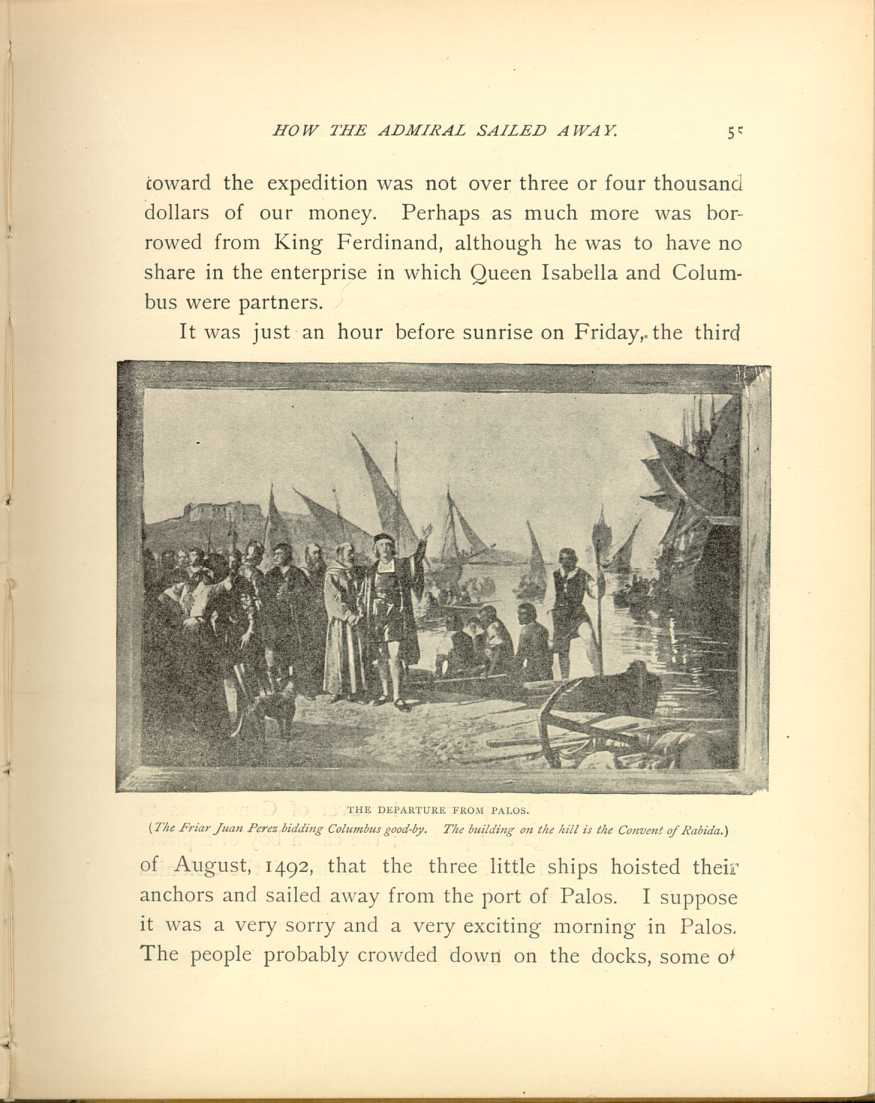
THE DEPARTURE FROM PALOS.
[Description:
Illustration of Columbus saying good-by to Friar Juan Ferez.
]
(The Friar Juan Ferez bidding Columbus good-by. The building on the
hill is the Convent of Rabida.)
But how different Columbus must have felt as he stepped, into the rowboat that took him off to his "flag-ship," the Santa Maria. His dreams had come true. He had ships and sailors under his command, and was about to sail away to discover great and wonderful things. He who had been so poor that he could hardly buy his own dinner, was now called Don and Admiral. He had a queen for his friend and helper. He was given a power that only the richest and noblest could hope for. But more than all, he was to have the chance he had wished and worked for so long. He was to find the Indies; he was to see Cathay; he was to have his share in all the wealth he should discover and bring away. The son of the poor wool-weaver of Genoa was to be the friend of kings and princes; the cabin boy of a pirate was now Admiral of the Seas and Governor of the Colonies of Spain! Do you wonder that he felt proud?
So, as I have told you, just before sunrise on a Friday morning in August, be boarded the Santa Maria and gave
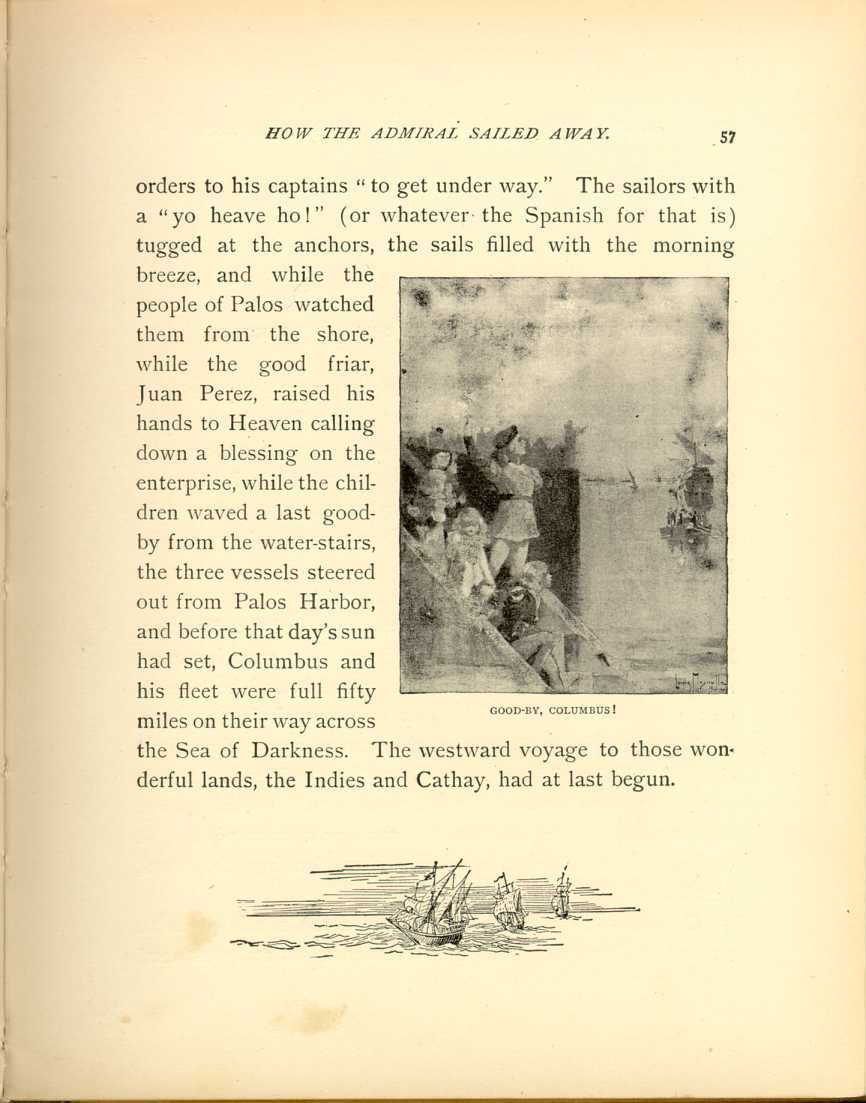
GOOD-BY, COLUMBUS!
[Description: Illustration of several children waving good-by to Columbus from the water stairs. ]|
CHAPTER IV.
HOW THE ADMIRAL SAILED AWAY.
The True Story of Christopher Columbus, Called the Great Admiral | ||